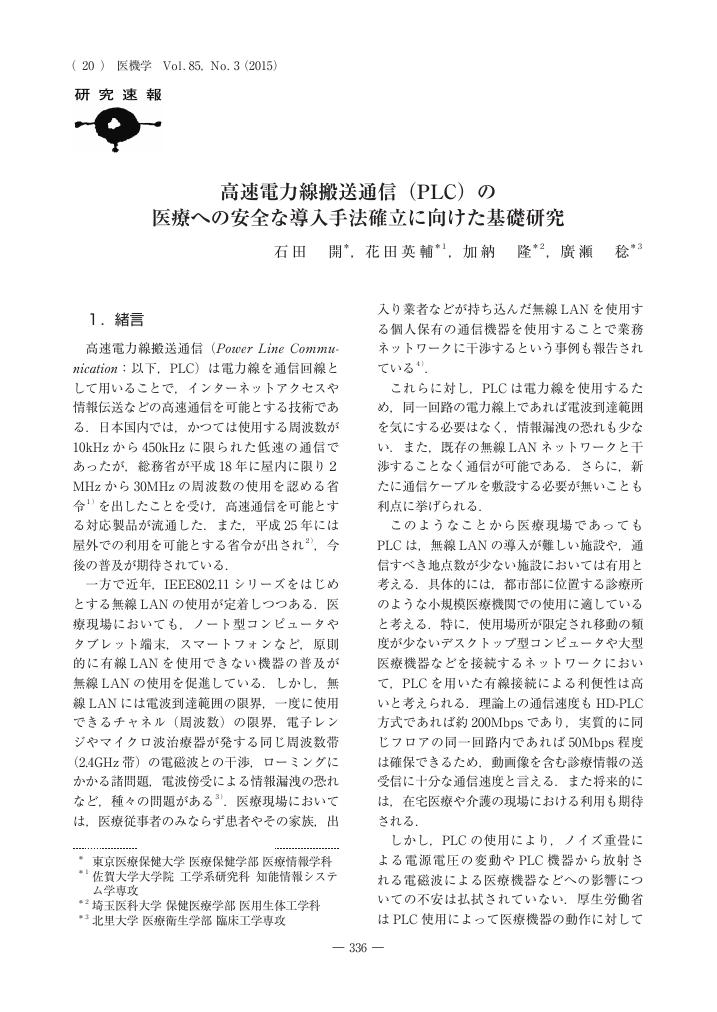2 0 0 0 OA 高速電力線搬送通信(PLC)の医療への安全な導入手法確立に向けた基礎研究
- 著者
- 石田 開 花田 英輔 加納 隆 廣瀬 稔
- 出版者
- 一般社団法人日本医療機器学会
- 雑誌
- 医療機器学 (ISSN:18824978)
- 巻号頁・発行日
- vol.85, no.3, pp.336-342, 2015 (Released:2015-09-11)
- 参考文献数
- 12
- 被引用文献数
- 1
- 著者
- 石田 開 鈴木 啓太 花田 英輔 廣瀬 稔
- 出版者
- 一般社団法人日本医療機器学会
- 雑誌
- 医療機器学 (ISSN:18824978)
- 巻号頁・発行日
- vol.87, no.3, pp.324-331, 2017 (Released:2017-08-02)
- 参考文献数
- 14
Light Emitting Diode (LED) lamps have become widespread in the clinical settings. However, electromagnetic noise from LED lamps could be problematic. In hospitals, the reception level of signals from medical telemeters might decrease after replacing traditional lighting with LED lamps. To investigate the effects of noise radiated from LED lamps on medical telemeters, we measured the electric field intensity of 34 types of LED lamps. Many of them emit 400 MHz band noise, and some types of LED lamps had increased floor level noise of 30 dB. We also observed artifact noises on electrocardiogram and respiratory waveforms when an LED lamp was placed next to the patient monitor. This effect was observed only when a medical telemeterʼs transmitter and a LED lamp were placed quite close. When approximately 50 cm apart, patient monitorsʼ signals were received normally. In hospitals, AC power supply cables and lamps are often placed near transmission cables, including leaky coaxial cables (LCX), as antenna of the patient monitors. To prevent interference with medical telemeters, selecting low noise LED lamps and maintaining sufficient separation between LED lamps and receiving antennas or LCX is necessary.
1 0 0 0 携帯電話機能抑止装置が医療機器・無線LANに及ぼす影響
- 著者
- 石田 開 廣瀬 稔 池田 憲昭
- 出版者
- 一般社団法人日本医療機器学会
- 雑誌
- 医療機器学 = The Japanese journal of medical instrumentation (ISSN:18824978)
- 巻号頁・発行日
- vol.83, no.1, pp.13-21, 2013-02-01
- 参考文献数
- 29
Cell-phones have a possibility to interfere with medical equipment, and using a cell-phone is restricted in some or all areas in many medical institutions. Cell-phone jamming equipment (CJE) has been introduced in critical areas to prevent cell-phone use. The CJE that were developed for medical use will not interfere with medical equipment nor other communication systems. There are many such devices that one can easily get on the internet or by mail order. This study investigated the malfunction of irradiated medical equipment and Wireless LAN (WLAN) by that type of CJE. We investigated 20 medical devices and 3 WLAN routers. The CJE interfered with four types of medical equipment and all WLAN routers that were investigated. One syringe pump raised an occlusion alarm and stopped infusion at a maximum distance of 22 cm from the CJE. One WLAN router was disconnected at a maximum distance of 6.2 meter. The maximum interference distance of medical equipment was comparatively smaller than that of the WLAN routers. Therefore, serious malfunction of medical equipment by CJE is probably not threatening. However, the malfunction of WLAN might affect clinical work using networks, because some WLAN routers or communication systems were susceptible to interference by CJE.
1 0 0 0 OA 携帯電話機能抑止装置が医療機器 · 無線LANに及ぼす影響
- 著者
- 石田 開 廣瀬 稔 池田 憲昭
- 出版者
- 一般社団法人日本医療機器学会
- 雑誌
- 医療機器学 (ISSN:18824978)
- 巻号頁・発行日
- vol.83, no.1, pp.13-21, 2013 (Released:2013-07-19)
- 参考文献数
- 29
Cell-phones have a possibility to interfere with medical equipment, and using a cell-phone is restricted in some or all areas in many medical institutions. Cell-phone jamming equipment (CJE) has been introduced in critical areas to prevent cell-phone use. The CJE that were developed for medical use will not interfere with medical equipment nor other communication systems. There are many such devices that one can easily get on the internet or by mail order. This study investigated the malfunction of irradiated medical equipment and Wireless LAN (WLAN) by that type of CJE. We investigated 20 medical devices and 3 WLAN routers. The CJE interfered with four types of medical equipment and all WLAN routers that were investigated. One syringe pump raised an occlusion alarm and stopped infusion at a maximum distance of 22 cm from the CJE. One WLAN router was disconnected at a maximum distance of 6.2 meter. The maximum interference distance of medical equipment was comparatively smaller than that of the WLAN routers. Therefore, serious malfunction of medical equipment by CJE is probably not threatening. However, the malfunction of WLAN might affect clinical work using networks, because some WLAN routers or communication systems were susceptible to interference by CJE.
- 著者
- 寺川 志奈子 田丸 敏高 石田 開 小林 勝年 小枝 達也
- 出版者
- 一般社団法人 日本発達心理学会
- 雑誌
- 発達心理学研究
- 巻号頁・発行日
- vol.22, no.3, pp.274-285, 2011
5,6歳児が,4人のグループで均等分配できない15個の飴を分配するという,対人葛藤が生起しやすい場面においてどのような行動をとるか,分配場面に至るまでに遊びを通して形成されてきたグループのピア関係の質との関連において検討することを目的として,「保育的観察」という約45分間の保育的な遊びのプログラムを設定した。保育的観察は,初めて出会う同性同年齢の4人が,保育リーダーのもと,親子遊び,親子分離,子ども4人だけの自由場面1,保育リーダーによって組織された遊び(あぶくたった),再び子どもだけの自由場面2,子どもどうしによる飴の分配を経験するという一連の過程からなる。グループの遊びの質的分析から,自由場面1から2にかけて,4人の遊びが成立しにくい状態から,5歳児は「同調的遊び」へ,6歳児は「テーマを共有した,役割分担のあるルール遊び」へと,4人がいっしょに,より組織化した遊びに参加するようになるという時系列的変化が明らかになった。すなわち,遊びを通してグループのピア関係の成熟度が高まっていくプロセスが捉えられた。また,飴の分配に関しては,6歳児では,自由場面2においてピアとして高い成熟度を示したグループの方が,そうでないグループに比べて,均等分配できない数の飴の分配という対人葛藤が生起しやすい場面において,グループ全体を意識した相互交渉による問題解決を図ろうとすることが明らかになった。
